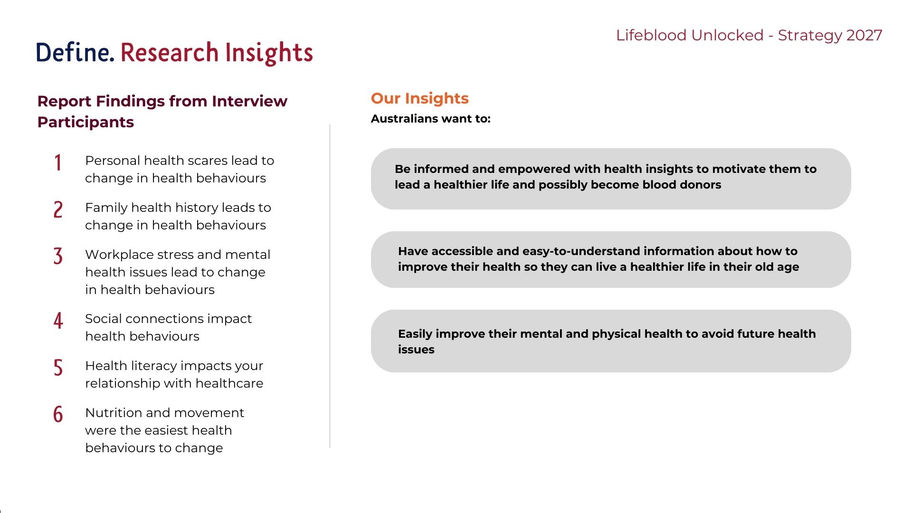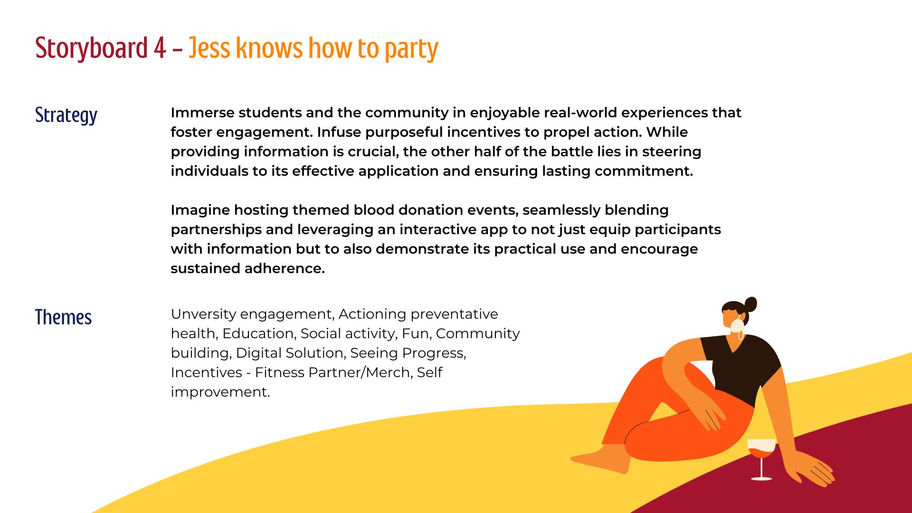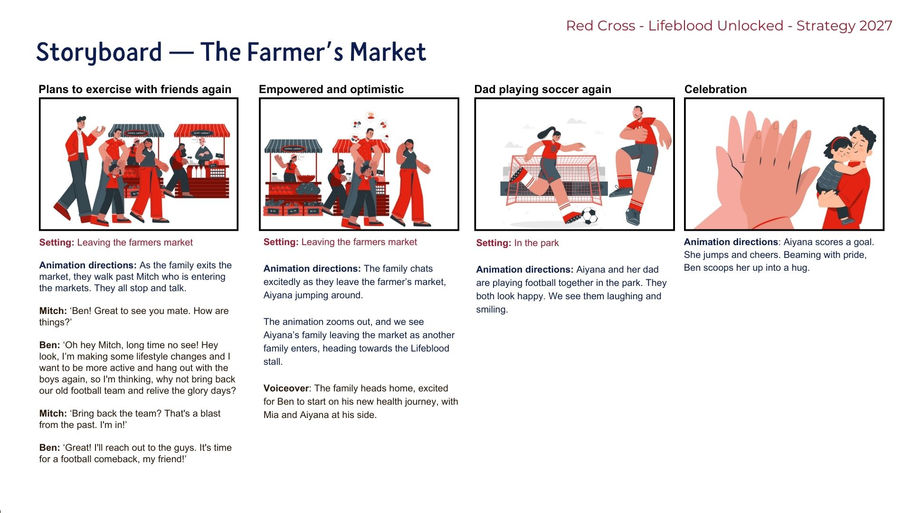
Red Cross
In this project we collaborated with stakeholders in a design sprint to create a short animated vision video for Red Cross Lifeblood, effectively communicating the Preventative Health strategy. Facilitated strategic decision-making for Lifeblood 2027.
Timeline
Nov - Dec 2023
(5 weeks)
Role
UX Research& Design
Project Type
Concept Research |
Business Case
Industry
Preventative Health & Community Service
01
Situation
Company Overview
The Australian Red Cross Lifeblood is a part of the Red Cross Society with a focus on the collection, testing and distribution of life-saving blood and therapeutics. Lifeblood also oversees the MilkBank for newborns and struggling mothers, as well as MicroBiome for poo donations and faecal microbiota transplants.
Project Background
In June of this year (2023), Lifeblood launched a new strategy called Unlocked 2027. This strategy has two ambitious drivers: 'A Movement of Donors' and 'Essential to Health'. It's the first time Lifeblood, under the guidance of the new CEO Stephen Cornellisen, has proactively opened the door to population health capabilities that extend beyond blood collection. As this still in the early stages (only 4 months into the new strategy) there's much dust to settle and vision to clarify. This project will be instrumental in bringing the vision to life.

02
Task
Primary Objective
Our primary objective in this project is to create a clear vision for the Red Cross Lifeblood Preventative Health strategy, with creative and strategic support to help the executive team make wise decisions about the 2027 strategy. This includes pitching the idea for endorsement from the executives, simplifying presentations with visuals, creating internal assets, and using visuals to encourage empathy for beneficiaries.
Key Deliverables:
-
A short video animation for an exec or board audience to have their “a ha!” moment of what this means and the benefit to lifeblood.
-
A visual on a page that articulates the same vision and how we’ll get there.
-
A visual showing the breadth of possibilities and who the beneficiaries of these services.
03
Action
Step 1: Project Planning
We start this group project by crafting a plan to clarify details for both team members and the client, with the goal of achieving alignment within the group and clearly communicating our approach and scope to the client.
Step 2: Research & Understanding The Problem
In our research phase, we worked closely with our client and stakeholders to understand their vision for preventative health and to learn more about their existing research. We also collaborated with frontline medical staff to ensure that our approach would be effective and aligned with real-world operations. Additionally, we conducted market research to understand current trends, which will inform the next stage: ideation.
Research Insight
Step 3: Initial Ideation
In the beginning of ideation stage, we used Affinity Mapping to help us spot recurring patterns in the data we collected during both research and brainstorming. This helped us concentrate on particular strategies and transform our insights into potential opportunities using How Might We statements.
Our Strategy Framework
1
Brand
centered
2
Donor
centered
3
Partnership
centered
How Might We

Step 4: Storyboard Ideation & Development
This phase was one of the longest and most challenging in our project, as we needed to make sure our concept could be implemented by frontline workers and fit with current trends and target market behaviors.
We began by coming up with many different ideas and gradually refined them to better meet stakeholder needs, always considering how practical they would be. We iterated often, incorporating feedback from clients and stakeholders after each meeting, making small changes to perfect the final concept, with the goal of developing the best possible idea for the final presentation.
Preliminary Concepts
And after several rounds of ideation and refinement, making various changes and mixing different elements, we finally developed one final storyboard that both the client and stakeholders, as well as all of us, can engage with and be happy about.
Here we present our storyboard ...
Final Concept
And of course, some more refinement before our final presentation.

04
Result
Video Animation Campaign
What the Storyboard Achieved
1. Tied together three of the four strategy pillars in a single scenario (movement of donors, essential to health, a workforce of champions)
2. Addressed three key opportunities for Lifeblood: Donor acquisition, donor retention and public health improvement
3. Addressed the risk averse nature of the executive team by showing a story that sparks their imagination and envision how the strategy is feasible
4. Showed the breadth of capabilities that Lifeblood could offer and the wide range of stakeholders it could positively impact, whilst being low risk
Roadmap Visual AssetVisual Asset
Demonstrate over 3 years who the beneficiaries of these services are, and the breadth of possibilities to help the audience develop greater empathy for them.
.png)
05
Conclusion
We successfully delivered a clear vision that integrated three key Lifeblood preventative health strategies (Donor Movement, Essential to Health, and Workforce Champion) into a single animated video. This video assists our client in pitching the idea for endorsement from the executives, thereby supporting informed decision-making for the 2027 strategy.
What I've Learned
This is my very first client project. Although it wasn't directly focused on user experience research and interface design, I still learned a great deal:
-
I learned about client and stakeholder communication and engagement, and how to effectively deal with stakeholders.
-
I gained insight into how to consider the practical implementation of ideas.
-
I learned to work in a large team and developed the confidence to speak up and share ideas in a big team setting.
Overall, this project has significantly enriched my skills and prepared me for future challenges in business-based client projects.























